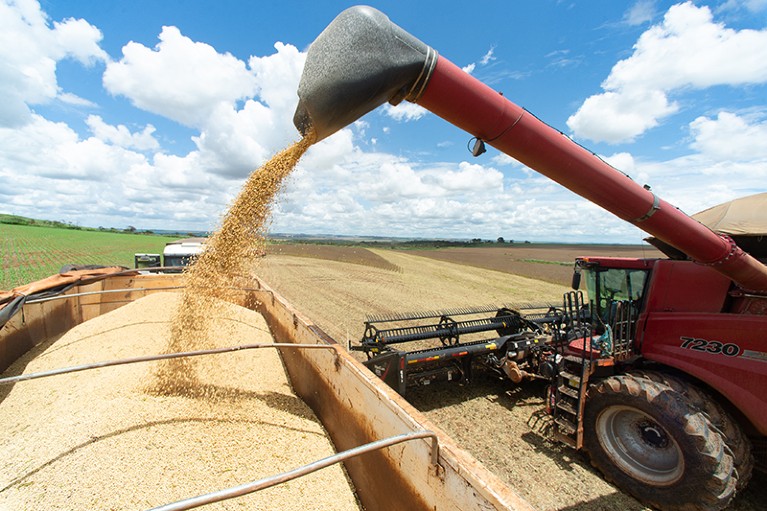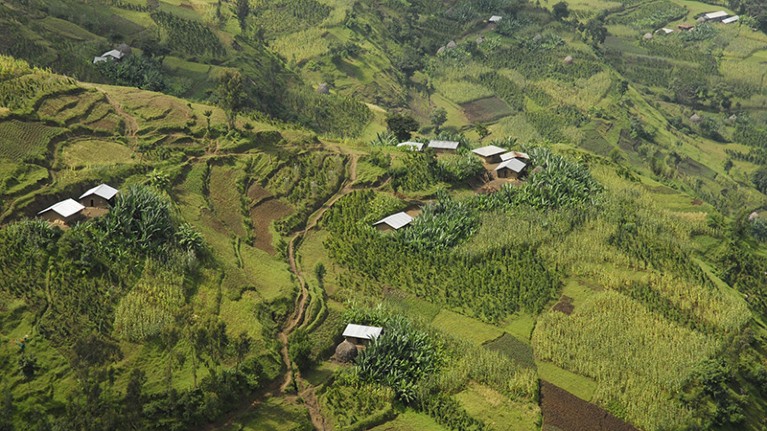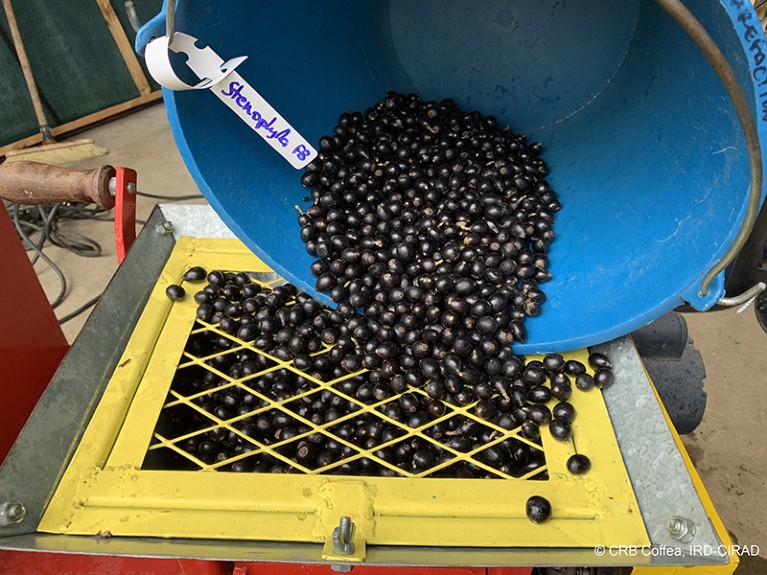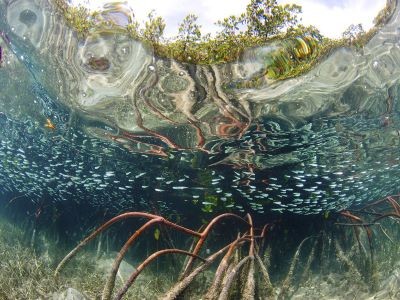I grew up in Campinas, a city in southeast Brazil. The apples there, cultivated from European varieties since the 1960s, tasted sweet. But, given the choice, I would always pick papayas grown in our garden. My father, who knew that growing a temperate fruit tree in a tropical country seldom worked, instead filled our garden with tropical ones, including two varieties of papaya. Meanwhile, drawing on knowledge from her Indigenous roots, my mother grew all sorts of herbs in pots around the house, which she used to treat ailments such as diarrhoea and indigestion.
Indigenous peoples and other local communities, who might have lived in a region for thousands or hundreds of years, respectively, have long acted as foragers, growers and shapers of nature1. In many parts of the world, the food production systems developed by such communities — from irrigated crops to agroforestry systems — have been the dominant food systems supporting regional economies, and feeding rural and urban areas alike2.
For the past three decades, various efforts involving academic and industrial partners have explored how biodiversity in low- and middle-income countries could be exploited commercially — bioprospected — for new pharmaceuticals and crop varieties, and how benefits could be shared equitably. Yet there are huge power imbalances between the wealthy countries and large corporations seeking the products, and the biodiversity-rich but economically and technologically deprived countries and communities providing them. In practice, the benefits rarely reach the people who are the knowledge holders and guardians of biodiversity and agrobiodiversity3.
Today, food production is the biggest driver of biodiversity loss and contributes heavily to climate change and pollution — the three components of the ‘triple planetary crisis’ recognized by the United Nations as requiring resolution if humanity is to create a viable future on this planet. As such, there has never been more need to establish how Indigenous and local knowledge can contribute to the building of resilient, sustainable and nutritious food systems in a way that is equitable.
As others have noted4, people from Indigenous and local communities who provide their knowledge to research must be involved from the start, take the lead on projects whenever possible and receive tangible, long-lasting benefits from them. But my work as director of science at the Royal Botanic Gardens, Kew, in London has convinced me that these goals are not enough. (Kew is collaborating with some 400 organizations in more than 100 countries to develop nature-based solutions to food insecurity, biodiversity loss and the effects of climate change.)
Fundamentally, there needs to be a transformation in the way agricultural science — indeed, all of science — is conducted. Assumptions about what counts as legitimate scientific knowledge must be questioned5. A greater appreciation of the wealth of information held as a result of humans living with and using species over hundreds or thousands of years must be developed. And the diverse needs of countries and communities across the world must be much better understood.
The move to monoculture
The ways in which plants are used by societies around the world have narrowed drastically over the past 500 years6. This has happened largely because of efforts to maximize yield and profit, pursued with little regard for Indigenous peoples and smallholder producers and the knowledge they hold.
Much of this narrowing occurred during clashes between Indigenous populations and imperial powers. In the Americas alone, around 90% of the continent’s Indigenous population — some 56 million people — died as a result of conflict and disease between 1492 and 16007. In subsequent centuries, such powers enslaved or displaced surviving communities by clearing swathes of tropical ecosystems to grow sugar cane, cotton, coffee, maize (corn) and other commodities8 that they had ‘discovered’ in their colonies9. In their hunt for the highest yields of cotton, the sweetest maize and so on, colonists ignored many of the agricultural practices that had been developed for a rich collection of locally adapted crops6.

In the past century, Indigenous knowledge has been dismissed in different ways. Take the Green Revolution, a vast increase in the production of food grains in the decades after the Second World War. This resulted mainly from the introduction of high-yielding crop varieties and changes to agricultural practices, such as the use of machinery and chemical inputs.
By tripling cereal production within four decades, the spread of agricultural technologies helped to alleviate hunger and poverty in some places. However, in others it created food insecurity and exacerbated pollution, deforestation and the displacement of Indigenous and small-scale production systems.
Consider the Cerrado in South America, where some of my Indigenous ancestors lived sustainably for millennia — now home to around 100,000 Indigenous people who represent more than 80 ethnicities. Since the 1970s, more than 40% of the Cerrado’s naturally acidic soil has been transformed into agricultural land, in part through the addition of five tonnes of pulverized chalk or limestone per hectare, among other inputs. About 20% of that land is used to grow soya beans to provide fodder for cattle farms that are mainly overseas10. Because of the heavy reliance on machinery, relatively few local people are employed in the fields, and leakage of pesticides into drinking water has been linked to deaths among farmers11.
Between the 1960s and 1980s, only three energy-rich crops — first wheat, then rice and maize — came to dominate international trade, replacing regional species and varieties of pulses, cereals, fruits and vegetables. (Smallholder farmers continued to grow and supply the latter to rural and urban areas6,8.)

How to include Indigenous researchers and their knowledge
Crops such as cassava, sorghum and certain millets were eventually added to breeding programmes in tropical regions, and from the 1980s, varieties developed under a global partnership called the Consultative Group for International Agricultural Research (CGIAR) were made available to national research centres. This meant that breeders could modify them so they were better adapted to local conditions12. Even so, Indigenous peoples often point out that, unlike the food systems created by the Green Revolution, their systems have always been diverse, resilient, sustainable, nutritious and circular — meaning that resources are used efficiently with little waste and moderate levels of consumption7,13.
As critics have noted, the Green Revolution was a top-down, state-led process, principally shaped by US priorities and ideologies14 that downplayed the importance of Indigenous and local knowledge. Indeed, in his Nobel Peace Prize lecture in 1970, US agronomist Norman Borlaug — who spearheaded the Green Revolution — talked about solutions “to cure all ills of a stagnant, traditional agriculture”.
Old solutions for new problems
Crop growers worldwide face enormous challenges. Plants are becoming less resistant to pests and diseases. Crops are more likely to be damaged or fail because of droughts, heatwaves, floods, salinization and rising sea levels. Soils are degraded; rivers and watersheds are polluted; and the diversity and abundance of crop pollinators are in steep decline. Meanwhile, food production contributes to around 37% of greenhouse-gas emissions15. And changes in land use associated with it are the greatest threat to terrestrial biodiversity16.
For humanity to progress towards a sustainable world with a secure food supply, the data now clearly show that we must change diets, reduce waste, diversify food systems — in existing or reduced agricultural land — and develop more-circular ways to produce food16,17. It is also becoming apparent that ‘climate-smart’, environmentally sustainable food sources can come from underutilized plants and wild relatives of crop plants. Efforts to locate and manipulate such food sources should be guided by the communities who have long been using them, and who might be the main beneficiaries18. (Most current work on crops largely entails mapping and editing genes and their functions in only a few dozen species.)
Bananas are one example. The seemingly incurable fungal infection Panama disease is affecting dense banana plantations across the tropics, posing a major threat to the global trade of bananas, which is currently dominated by the Cavendish variety. Yet the disease does not affect crops in Africa and southeast Asia, where Indigenous and local communities grow hundreds of varieties that are naturally resistant to it. In Uganda alone, nearly 100 varieties of banana contribute to the sustainable livelihoods of millions of people19.

Likewise, the plant enset, also called the tree against hunger (Ensete ventricosum), is hardly known outside southwestern Ethiopia. But in this region, where it has probably grown for millennia, its starch-filled stems provide more than 20 million people with their main source of calories and nutrients. Its leaves are used to feed cattle, to provide shade and to build roofs; the stems provide fibres for basket-making; and when planted in rows, enset is used in place of fences to define land ownership and reduce conflicts. Perhaps most importantly in relation to climate change, enset is remarkably tolerant of drought and short-term temperature variations20.
Almost 500 million Indigenous people, speaking at least 4,000 languages, occupy more than 25% of the global land surface. They often have the best ecological knowledge about the region they live in, and know which species are most important for their communities21. They also hold taxonomic knowledge that has been neglected by scientists from elsewhere.
For instance, Indigenous Iban and Dusun communities in southeast Asia have long recognized that two similar-looking fruits, lumok and pingan, originate from two distinct plants. Yet for nearly two centuries, Western botanists had misclassified them as coming from a single tree species22.
In principle, Indigenous and local knowledge could help to create training data sets. These could enable researchers and crop developers to find food sources that contain certain nutrients, that will tolerate anticipated climate shifts or that harbour resistance to emerging pests and pathogens. Phylogenomic models and artificial intelligence could then mine these data to predict the occurrence and function of genes that underlie useful traits across the tree of life23. And with genomic sequencing and gene-editing techniques becoming more accessible and affordable, more of the work to modify and cultivate species and varieties could happen at local and regional levels.
Routes to agrobiodiversity
Some might question why Indigenous and other communities would want to get involved in projects focused on the development of food crops after centuries of being exploited, mistreated and ignored.
Numerous efforts over the past three decades have been problematic for various reasons. Promises to share benefits equitably have not been kept owing to unequal power relations, unclear legislation around access to biological and genetic resources and the sharing of benefits, and complex financial mechanisms for transferring them24.
Harms are ongoing. In 2007, a Dutch company gained patent rights for storing and processing a grain called teff, which has been used by Ethiopian people for thousands of years. Although an agreement for access and benefit sharing was signed in 2005, the expectations of multiple benefits to Ethiopian knowledge providers were not met. Only in 2019 did a court in the Netherlands rule that the patent was invalid.
I am under no illusion about what it will take to achieve true collaboration at scale — both at the individual and systemic level. Yet in my interactions with Indigenous people and local communities, people’s generosity and willingness to work collaboratively has impressed me again and again.

Although Indigenous communities have yet to receive the recognition they deserve, food-security workshops involving Indigenous people and local communities are beginning to shape research agendas25 — such as those organized under the Colombia Bio programme involving multiple Colombian and British stakeholders, and co-led by colleagues at Kew. By adopting more-holistic and more-sustainable views on the management of nature, and focusing on the relationships between human and non-human species4, Indigenous peoples are challenging the status quo of economic growth at the cost of natural capital. Also, some Indigenous and local communities are already active in international debates about food security, biodiversity and climate change. Many are authoring key reports and voicing their perspectives, such as through the United Nations Food and Agriculture Organization2,13 and during the UN biodiversity conference (COP15) held last month in Montreal, Canada.
With the backing of multilateral initiatives, such as the World Food Programme, and regional organizations, such as the Pan-African Council, funding agencies could promote collaboration of Indigenous and other local communities with crop-development scientists from Europe, the United States, China and other countries. The US National Science Foundation or the Horizon Europe programme, for example, could make funding calls specifically for biocultural research related to food security and non-conventional food crops. And grants could be evaluated partly on the basis of how much applicants propose to work on projects involving partnerships with Indigenous peoples and local communities, or on whether grants are initiated and led by collaborators from the global south.
Governments in high-income countries could earmark part of their official development-assistance funds or other sources to support knowledge exchange within countries and between the global south and global north. They could also build national and regional infrastructure for plant breeding programmes, and revise agricultural policies and subsidies to support more-diverse, sustainable and locally adapted food systems that are built on conventional and non-conventional crops.

Africa: sequence 100,000 species to safeguard biodiversity
But meaningful change — at scale — also requires scientists worldwide to re-evaluate their fundamental assumptions, and re-examine how they work with partners across cultures and power structures26.
Take conservation. As noted by others, approaches to protecting ecosystems are often centred on the concept of some ideal ‘wilderness’ state. Yet nearly all landscapes have been actively managed and shaped by Indigenous people and local communities for millennia. Dominant narratives about ‘pristine’, people-free nature carry little, if any, regard for Indigenous and local ways of knowing, using and living in these landscapes27.
Equity must be reflected in authorship lists, intellectual-property rights, patents and other forms of monetary and non-monetary sharing of benefits derived from research. But even the use of language in research, which reflects deeply entrenched biases and power imbalances, must be rethought5.
Plant breeders and other stakeholders often point to the need for capacity building in low-income countries, for instance. The way the term is used overlooks the fact that people in these countries already have extensive knowledge and experience4 — ‘capacity’ of their own, even if they lack infrastructure, equipment and some technical knowledge. Likewise, researchers continue to report the ‘discovery’ of a new species (including in this journal), even when local communities have known about that species for hundreds or thousands of years.
Various initiatives are already helping to make biodiversity and agriculture research more accessible and inclusive. Since 2021, Africa’s continental platform for open-access publishing has made studies conducted in Africa freely available, for the primary benefit of other researchers on the continent. Likewise, the African BioGenome Project aims to develop a major genomics resource in Africa to assist breeders and conservationists.
Around the world, botanical gardens, natural-history museums and private and public research and development organizations are trying to forge a better way forward.
At Kew, we are doing the same. My colleagues, together with around 210 collaborators from more than 40 countries, have compiled information about more than 7,000 plant species with documented uses as human food in an effort spanning more than 20 years21,28. We are digitizing our collections of some 7 million plant and 1.2 million fungal species, so that users anywhere in the world can have free access to high-resolution images and their associated data. And we are offering in-person courses in conservation science, seed-banking and biodiversity in more than 30 countries and territories worldwide, reaching many more people and regions online.
When I go back to Brazil, I always visit a local fruit and vegetable market. I spend hours chatting to the farmers, smelling and tasting the local produce and learning more about how they grow such an amazing diversity of edible plants. Their stories about what they are growing where — and most of all, their enthusiasm — give me hope that biodiversity is coming back to our lives, and will stay.
References
-
Levis, C. et al. Science 355, 925–931 (2017).
-
FAO. Indigenous Peoples’ Food Systems: Insights on Sustainability and Resilience from the Front Line of Climate Change (FAO, Alliance of Bioversity International & CIAT, 2021).
-
Moran, K., King, S. R. & Carlson, T. J. Annu. Rev. Anthropol. 30, 505–526 (2001).
-
Brondízio, E. S. et al. Annu. Rev. Environ. Res. 46, 481–509 (2021).
-
Smith, L. T. Decolonizing Methodologies: Research and Indigenous Peoples (Bloomsbury, 2021).
-
Khoury, C. K. et al. New Phytol. 233, 84–118 (2022).
-
Koch, A., Brierley, C., Maslin, M. M. & Lewis, S. L. Quat. Sci. Rev. 207, 13–36 (2019).
-
McCann, J. C. Maize and Grace: Africa’s Encounter with a New World Crop, 1500–2000 (Harvard Univ. Press, 2005).
-
Das, S. & Lowe, M. J. Nat. Sci. Collect. 6, 4–14 (2018).
-
Rausch, L. L. et al. Conserv. Lett. 12, e12671 (2019).
-
Braga, A. R. C., de Rosso, V. V., Harayashiki, C. A. Y., Jimenez, P. C. & Castro, Í. B. Nature Food 1, 312–314 (2020).
-
Pingali, P. L. Proc. Natl Acad. Sci. USA 109, 12302–12308 (2012).
-
FAO. The White/Wiphala Paper on Indigenous Peoples’ Food Systems (FAO, 2021).
-
Cabral, L., Pandey, P. & Xu, X. Agric. Hum. Values 39, 249–267 (2022).
-
IPCC. Climate Change and Land: An IPCC Special Report on Climate Change. Desertification, Land Degradation, Sustainable Land Management, Food Security, and Greenhouse Gas Fluxes in Terrestrial Ecosystems (eds Shukla, P. R. et al.) (IPCC, 2019).
-
Díaz, S. et al. Science 366, eaax3100 (2019).
-
Willett, W. et al. Lancet 393, 447–492 (2019).
-
Pironon, S. et al. Nature Clim. Change 9, 758–763 (2019).
-
Hamilton, A. C., Karamura, D. & Kakudidi, E. Plant Divers. 38, 23–44 (2016).
-
Borrell, J. S. et al. Ann. Bot. 123, 747–766 (2019).
-
Ulian, T. et al. Plants People Planet 2, 421–445 (2020).
-
Gardner, E. M. et al. Curr. Biol. 32, R511–R512 (2022).
-
Cantwell-Jones, A. et al. Nature Plants 8, 225–232 (2022).
-
Vermeylen, S. Local Environ. 12, 423–436 (2007).
-
Swiderska, K. et al. Sustainability 14, 11311 (2022).
-
Ramírez-Castañeda, V. et al. Proc. Natl Acad. Sci. USA 119, e2122667119 (2022).
-
Fletcher, M.-S., Hamilton, R., Dressler, W. & Palmer, L. Proc. Natl Acad. Sci. USA 118, e2022218118 (2021).
-
Antonelli, A. et al. State of the World’s Plants and Fungi 2020 (Royal Botanic Gardens, Kew, 2020).